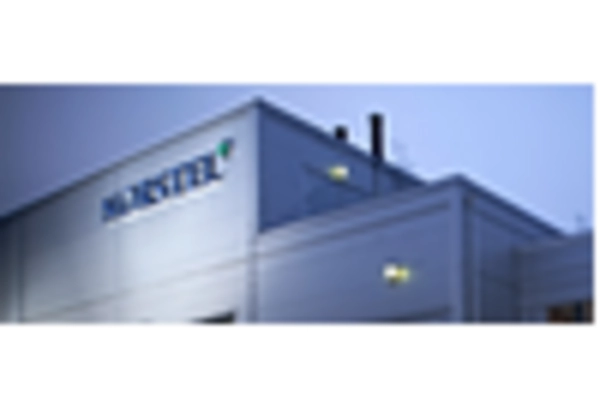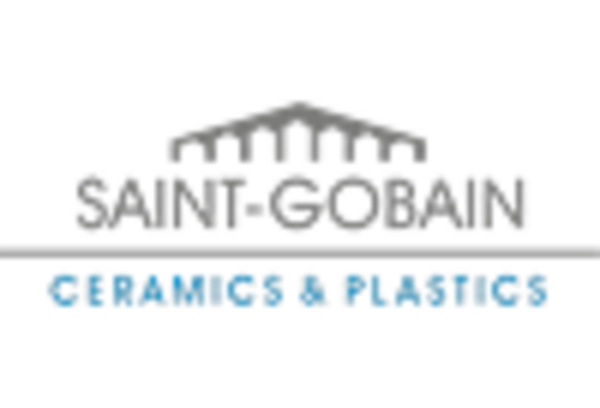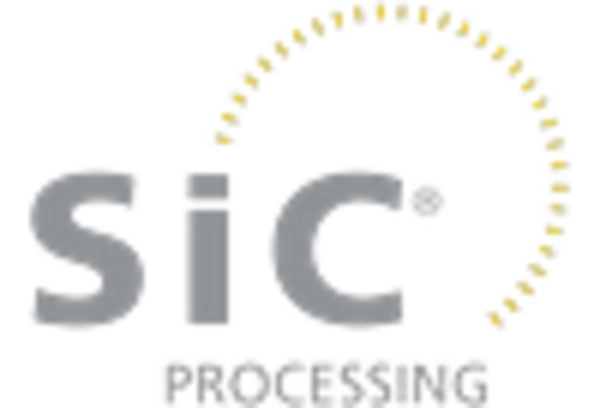Increasing Adoption in Automotive Sector
The Silicon Carbide Ceramics Market is experiencing a notable surge in demand from the automotive sector, particularly in electric vehicles (EVs). As manufacturers strive to enhance vehicle performance and efficiency, silicon carbide ceramics are increasingly utilized for components such as power electronics and thermal management systems. The market for silicon carbide in automotive applications is projected to grow at a compound annual growth rate (CAGR) of approximately 20% over the next five years. This growth is driven by the need for lightweight, high-strength materials that can withstand extreme temperatures and improve energy efficiency. Consequently, the integration of silicon carbide ceramics into automotive designs is likely to become a standard practice, further propelling the market forward.
Rising Demand for High-Performance Materials
The Silicon Carbide Ceramics Market is witnessing a rising demand for high-performance materials across various sectors, including aerospace, defense, and industrial applications. Silicon carbide ceramics are renowned for their exceptional hardness, thermal stability, and resistance to wear, making them ideal for applications that require durability and reliability. The market for high-performance ceramics is expected to grow at a CAGR of around 15% in the coming years, driven by the increasing need for materials that can withstand extreme conditions. This trend is particularly evident in the aerospace sector, where silicon carbide ceramics are utilized in components such as turbine blades and heat shields. As industries continue to prioritize performance and longevity, the demand for silicon carbide ceramics is likely to escalate.
Technological Innovations in Material Science
The Silicon Carbide Ceramics Market is significantly impacted by ongoing technological innovations in material science. Advances in manufacturing processes, such as additive manufacturing and sintering techniques, are enhancing the properties and applications of silicon carbide ceramics. These innovations are enabling the production of more complex geometries and improving the material's performance characteristics. The market is expected to see a substantial increase in the adoption of silicon carbide ceramics in various applications, including aerospace, automotive, and electronics, as these technologies become more accessible. Furthermore, research and development efforts aimed at optimizing silicon carbide formulations are likely to yield new applications, thereby expanding the market's potential. As a result, the interplay between technology and material science is expected to drive the growth of the silicon carbide ceramics market.
Growing Interest in Renewable Energy Solutions
The Silicon Carbide Ceramics Market is poised to benefit from the increasing interest in renewable energy solutions. As the world shifts towards sustainable energy sources, silicon carbide ceramics are becoming essential in the development of efficient solar panels and wind turbines. Their ability to withstand harsh environmental conditions while maintaining performance makes them a preferred choice for renewable energy applications. The market for silicon carbide in renewable energy is projected to grow significantly, driven by government initiatives and investments aimed at promoting clean energy technologies. This trend not only enhances the market's growth potential but also aligns with global sustainability goals, further solidifying the role of silicon carbide ceramics in the energy sector.
Expansion in Electronics and Semiconductor Industries
The Silicon Carbide Ceramics Market is significantly influenced by the expansion of the electronics and semiconductor sectors. Silicon carbide ceramics are increasingly favored for their superior thermal conductivity and electrical properties, making them ideal for high-performance electronic devices. The demand for silicon carbide in semiconductor applications is expected to reach USD 1.5 billion by 2026, reflecting a robust growth trajectory. This trend is largely attributed to the rising need for efficient power management solutions in various electronic devices, including smartphones, computers, and renewable energy systems. As the electronics industry continues to evolve, the reliance on silicon carbide ceramics is anticipated to intensify, thereby bolstering the market.















Leave a Comment